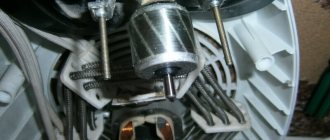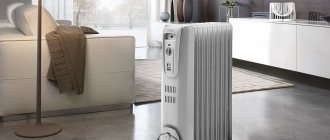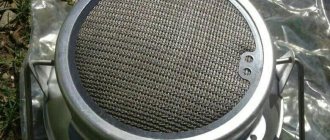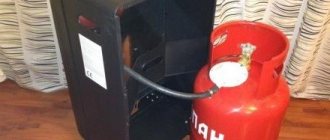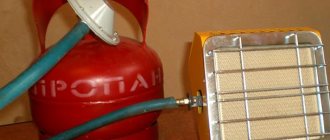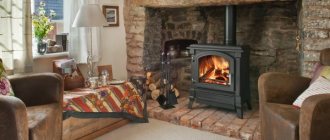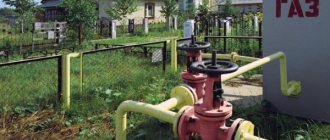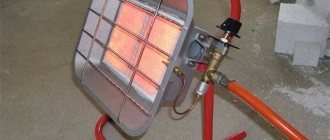Differences between a conventional electric convector and an inverter
Everyone has probably used an ordinary electric convector (popularly called simply “heaters”) at least once. The principle of its operation is this: when the set air temperature is reached, the thermostat turns off the heating element, and when it gets colder, it turns it on again. And it doesn’t matter whether the control is mechanical or electronic, just in the first case you will have an old-school “twist”, and in the second - a beautiful display indicating the temperature and buttons. But this mode of operation cannot be called energy efficient: in fact, a conventional convector operates on the on/off principle.
Inverter convectors work differently. As soon as the device heats the room to the set temperature, its “brains” give the command to reduce the heating power. The convector does not turn off the heating; instead, it begins to reduce the intensity of the heating element. The latter continues to work only to maintain the desired temperature, so the inverter convector consumes less energy.
Difference between electric and inventory convector
The effect is enhanced by the high sensitivity of the thermostat, which allows you to stably maintain the set temperature with an accuracy of 0.1 degrees Celsius.
Main characteristics
The latest inverter heaters operate in automatic mode. When the device reaches the set temperature mark, the system does not turn off, but switches to a reduced power level. Due to this scheme, the room will always have the required level of heat. The equipment is economical and consumes minimal energy, since there is no need to constantly turn the heater on and off.
Based on the principle of operation, an inverter heater for a home is similar to an air conditioner. Its main part is a heat pump with external and internal units. One of them contains a heat exchanger, inside of which freon is formed. Its temperature can rise to 80 degrees, after which it moves to an external unit with a lower pressure. After this, freon is converted from a liquid form to a gaseous state. As a result of this transformation, a large amount of thermal energy is produced.
In this video you will learn how to choose an inverter:
Thanks to this operating principle, the inverter heater is very efficient. It is able to create a comfortable temperature even in a very cold space.
Advantages and disadvantages
A modern electric inverter heater is the optimal solution for the home. The equipment has many advantages:
- Economical. The unit requires a small amount of current to operate. Due to the absence of the need to restart, the device operates for a long time. Compared to other devices, energy savings are 40%.
- Performance and practicality. The device warms even at extremely low temperatures without loss of efficiency.
- Environmental friendliness and safety.
- Almost silent operation. This criterion is achieved by reducing the rotation speed at partial load.
However, each equipment has its drawbacks. This heater was no exception. The inverter has the following disadvantages:
- High price compared to other types of heating systems.
- Sensitivity to sudden changes in voltage.
- Difficulty in selecting spare parts. The parts are not standard, so it may take several weeks to repair the equipment in the service.
Application in heating systems
The inverter device is successfully used in electric heating systems. The invention has a lot of positive reviews. It can be used in any place where there is access to electricity. This equipment can be used without special permission to install a heating system.
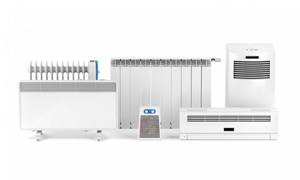
Such an inverter can easily replace a gas boiler
The unit is capable of replacing a traditional gas boiler . In this case, the heating system with a built-in inverter device will work as follows:
- Passing through the system, electricity will enter the boiler.
- The inverter boiler will produce an induction current.
- When the power is turned off, the equipment will continue to work thanks to the battery.
- The heater consists of a heat exchanger and a magnetic part.
Inverter heater and home heating with electricity
Inverter heaters, reviews of which are often positive, can be used for heating living spaces. This is especially true if the system is powered from the main power line. This method has already won many fans. Inverter heaters are installed wherever there is access to electricity.
Moreover, such equipment can be used without obtaining permits. This is another plus of the unit. In other words, to install a heating system, there is no need to contact the relevant authorities to obtain permission to install an inverter heater. Another pleasant point for users is the cost of equipment. This figure is significantly lower than the price of other heating systems.
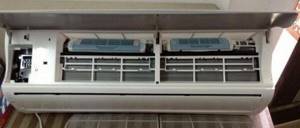
The use of inverters in heating
In the production of heating devices, inverters are used as a device that allows precise pre-setting or adjustment during operation of the unit.
High-tech electric heating devices that do not have heating elements, lamps, filaments and heating coils in their design necessarily include inverters as devices for increasing the functionality and efficiency of the heating unit. Such heating means include vortex induction heaters (VIN) and inverter air conditioners. Both of these devices are descended from their less advanced predecessors: VIN - from induction boilers of the SAV type, inverter split systems - from conventional air conditioning systems.
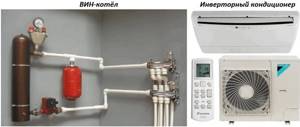
Types of devices
There are two types of inverter heaters - infrared and gas. The first type is used for heating residential and utility rooms, as well as cottages and verandas. Such equipment tolerates moisture and precipitation well.
The gas heater runs on natural and liquefied fuel. Its main advantage is its ability to maintain heat over large areas. This is a very productive device that operates with low fuel consumption. It is very easy to use and mobile.
In addition, there are inverter air conditioners. Heat pumps are incorporated into the mechanism of these devices.
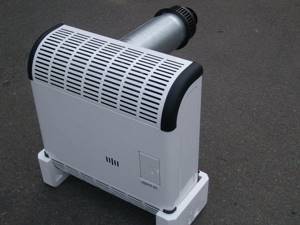
Inverters differ, at a minimum, in heating power
New generation air conditioners
Usually this equipment is associated only with cooling the air in the apartment. But it is not so. Inverter air conditioners can not only cool, but also warm the living space.
Such air conditioners are used in apartments and offices. But if the temperature in the winter is -26 degrees, the device will not be able to cope with heating the room alone. This option will be inconvenient for use in a country house or garage. The air conditioner is environmentally friendly. During its operation, no fuel is burned, therefore there are no emissions of harmful substances into the atmosphere.
Inverter air conditioners have many advantages . The following advantages of the systems are highlighted:
- Adjustment of the desired temperature occurs quickly.
- The device operates almost silently. This is achieved through built-in fans operating at low speed.
- Compared to other models, an inverter air conditioner saves up to 65% of electricity.
- When using the system, the occurrence of drafts is excluded, since there are no sudden temperature changes.
However, each mechanism has its drawbacks. An inverter air conditioner has the following disadvantages:
- Higher price compared to other types of systems.
- Sensitive electronics that respond to voltage fluctuations.
- Inability to turn on the compressor at temperatures of -10 and +42 degrees.
- Difficulty in selecting spare parts.
Equipment Manufacturers
The leader in the production of inverter air conditioners is Japan. It was in this country that such systems were first developed. Daikin produces wall-mounted equipment for residential maintenance. Air conditioners have minimal noise levels and also purify the air. Some models are equipped with a special energy saving sensor. If there is no one in the room for more than 20 minutes, the system switches to this mode.
A large selection of inverter air conditioners is also presented by Toshiba. The models have an original and effective design, suitable for any modern interior. The equipment reaches the set temperature 25% faster than other heaters. The system does not require large amounts of electricity to operate; on the contrary, it is consumed 2 times more economically. The models are equipped with an air filter that allows you to destroy 99% of pathogenic bacteria in the room.
Inverter heaters and air conditioners are excellent equipment for home and office use. The modern market can offer a wide range of models to suit every taste. In order for the devices to serve for a long time and properly, you should follow the manufacturer's recommendations.
Manufacturers and popular models: ranking of the best and prices
The most widespread use of inverter heaters in everyday life is in convector heaters and split systems - a new generation of air conditioners with an improved freon conversion mechanism.
Split systems
Among the manufacturers with a developed dealer network on the Russian market are Mitsubishi, Toshiba, Samsung, Aeronik. The most popular are models in the middle price segment, designed to heat a room of 20-30 m2. These are models with low noise levels - within 15-30 dB.
Ballu BEC/EVU-2500
pros
- Convenient control via smart Wi-Fi module
- Easy to install even by yourself
- There is overheat protection
- Interesting design
Minuses
- Short power cord
From 4,000 ₽
The review begins with the best heater, capable of heating the space around it in the shortest possible time. In this case, the module itself does not overheat, but remains at operating temperature. It works almost silently and is absolutely safe. If you are installing it on a wall, then the included mounting brackets are quite suitable. Otherwise, you may need to purchase additional fasteners.
Electrolux ECH/R-1500 T
pros
- Warms the air evenly
- Low cost
- Possibility of connecting a control unit
- Great design
- Convenient wall mounting
Minuses
- Gets dirty easily
From 3,000 ₽
If you need to choose an inverter heater for your home, it is recommended to pay attention to this model. Compact device with good characteristics. Guarantees excellent air heating at some distance from the source. At the same time, energy consumption is much more economical. Manufacturers have slightly modified the shape of the body so that the blinds redirect air flows with the greatest efficiency. The device reaches the desired temperature quickly enough.
Split system Aeronik ASO/ASI-12HM
Development of the Australian company Aeronik PTY LTD. The ASO/ASI-12HM model is positioned as the best solution for allergy sufferers; it is equipped with additional air purification and ionization filters. Another feature of this model is the interchangeable mirror panels of different colors, which allows you to conveniently fit it into the interior.
Characteristics:
- Power in cooling mode: 3200 W
- Power in heating mode: 3400 W
- Heating power consumption: 987 W
- Heating area: 33 m2
- Dimensions of the inner side (WxHxD): 80x29x18.6 cm
- Dimensions of the outdoor unit (WxHxD): 74.5×55.2×32.8
- Price: 23,600 rub.
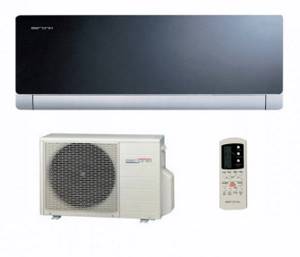
Toshiba RAS-07EKV-EE/07EAV-EE
Split systems of the EKV series are manufactured at the Toshiba plant in Thailand. The model is positioned as a low-power solution for servicing city apartments with small rooms.
Characteristics:
- Power in cooling mode: 2000 W
- Power in heating mode: 2500 W
- Heating power consumption: 590 W
- Heating area: 20 m2
- Inner side dimensions (WxHxD): 79×27.5×20.5
- Dimensions of the outdoor unit (WxHxD): 66x53x24
- Price: 25,100 rub.

Climate control unit Mitsubishi Heavy Industries SRK-25ZM-S
In terms of consumer properties, this is a premium model. It implements the most comfortable options for the distribution of heat flows. Air purity is ensured by multi-stage filtration, and constant ionization is also carried out even when the system is turned off due to the tourmaline coating of the block elements.
Characteristics:
- Power in cooling mode: 2500 W
- Power in heating mode: 3200 W
- Heating power consumption: 800 W
- Heating area: 25 m2
- Inner side dimensions (WxHxD): 79.8×29.4×22.9
- Dimensions of the outdoor unit (WxHxD): 78x54x29
- Price: 39060 rub.
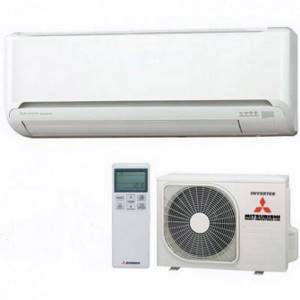
Samsung AR09HSSFRWK/ER
Modern split system from a South Korean manufacturer. The model belongs to the Luxury line. The AR09HSSFRWK/ER uses its own Visual Doctor technology to purify the air. Can operate in fan mode.
Characteristics:
- Power in cooling mode: 2500 W
- Power in heating mode: 3200 W
- Heating power consumption: 620 W
- Heating area: 26 m2
- Inner side dimensions (WxHxD): 93.6 x 27 x 26.4
- Outdoor unit dimensions (WxHxD): 79 x 54.5 x 28.5
- Price: 35,000 rub.
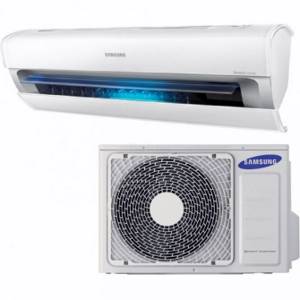
Convector heaters
According to consumers and experts, the most popular are convector heater models with a built-in inverter from Timberg and Huyndai.
Timberk TEC.E0 M 2000
Timberk convectors are manufactured in Finland. The TEC.E0 M 2000 offers floor and wall mounting options, rollover protection and UltraSilence technology.
Characteristics:
- Heating power: 2000 W
- Overall dimensions (WxHxD): 80x45x8 cm
- Weight: 4.6 kg
- Price: 2600 rub.
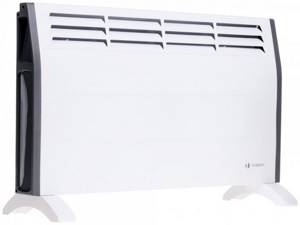
Pros and cons of the device
Advantages of an inverter heater:
- When the desired temperature is reached, the unit does not turn off, but switches to operation at low speeds.
- It doesn't waste a lot of energy because you don't have to constantly turn the device on and off. Energy savings compared to other heating devices are 30-50%.
- Maintains the set air temperature by smoothly controlling the speed of the compressor motor.
- The device has high performance. It is capable of heating even at very low temperatures.
- Safe and environmentally friendly.
- It operates almost silently, thanks to the built-in fan.
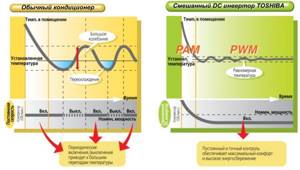
Advantages of inverter devices
The disadvantages include:
- High cost compared to other heating devices.
- Sensitivity to voltage changes.
- Spare parts are not standardized, so repairs may take several weeks.
Why is it economical
Inverter heaters are considered one of the most cost-effective devices. How does this manifest itself? Let's start with the fact that such systems, having reached the required temperature level, do not completely turn off. The device continues to operate, reducing the speed to a minimum. This process leads to maintaining a comfortable and favorable climate in the room. At the same time, the heater does not waste extra electricity turning it on and off.
In addition, inverter heaters do not use “high current” for starting during their use. This is also beneficial for consumers. When starting the unit, the current does not exceed the rated current. And this has a positive effect on the service life of such devices. In this case, the device is not constantly in the on and off mode. Such cycles significantly reduce the life of the equipment. It is worth noting that, unlike conventional heating devices, inverter heaters can save up to 40% of electricity.
Operating rules
In order for the device to serve for a long time, it is necessary to adhere to certain rules during operation:
- The distance from the heater to any object must be at least 500 mm.
- The unit cannot be placed under a window opening.
- Experts do not recommend leaving the device turned on overnight; this can only be done if there is a thermostat inside it that regulates the frequency of operation.
- You should not dry things on a heater.
Energy efficiency is now considered one of the most important criteria when choosing heating devices, so you should carefully approach the purchase of heaters. Unlike convective heating (central heating, oil radiators), inverter devices allow you to warm up that part of the air mass where people are, which is very convenient and profitable.


